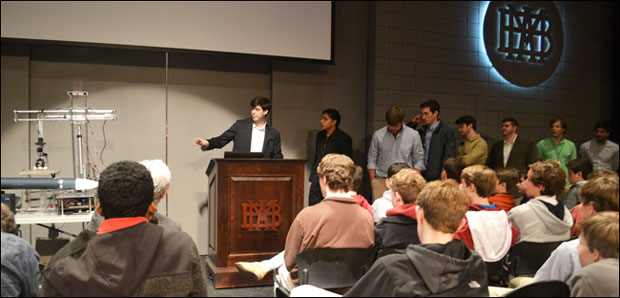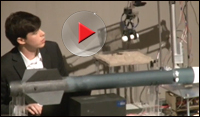
A robotic arm moves directly over a Vanderbilt Aerospace Club rocket. In the arm’s grippers is a white capsule the size of a hotdog bun.
“The arm moves nice and slow and safe like NASA likes it because failure is not an option,” said William Emfinger, graduate student mentor to the Aerospace Club.

When the capsule drops into an open payload bay near the nosecone, more than 700 young men erupt in hoots, applause and rhythmic foot stomping during a 9:45 a.m. assembly in Paschall Theatre on Montgomery Bell Academy’s campus.
Club members arrived at MBA at 7:15 a.m. to assemble and test its entry in the 2014-2015 NASA Student Launch (NASA SL) Challenge: An earth-simulated Mars Sample Recovery Vehicle that includes an Automated Ground Support Equipment Robot (AGSE, or robotic arm) that autonomously places an encapsulated soil sample in a Mars Ascent Vehicle (MAV).
NASA has standardized the 2015 competition by requiring all 31 teams to design the AGSE and the appropriate MAVs. The national challenge is a research-based, eight-month commitment to design, construct and fly high-power rockets with innovative payloads. At the competition the ascent vehicles — rockets — will be launched to a height of 3000 ft., with the sample capsule independently parachuted back to Earth.
NASA hopes to bring to Earth the first soil and rocks from Mars, and the process is set to begin in 2020 when the agency’s next rover is slated to cache samples for return by two as-yet planned future missions.
 The March 9 visit to Montgomery Bell, a college preparatory school for boys in grades 7-12 in Nashville, is one of several of the team’s educational outreach events during the academic year intended to generate enthusiasm and interest in aerospace and engineering.
The March 9 visit to Montgomery Bell, a college preparatory school for boys in grades 7-12 in Nashville, is one of several of the team’s educational outreach events during the academic year intended to generate enthusiasm and interest in aerospace and engineering.
After the demo, the Vanderbilt students visited a number of classes to continue discussion about the club’s NASA project and engineering in general. The Vanderbilt Aerospace Club has won top prize in the space agency’s student launch challenge for the past two years.
“The objective of the Vanderbilt rocket is to be the lightest and the lowest drag vehicle that has the most optimal chamber for sample retention, which can handle the very high-g loads during ascent and during recovery,” said rocket design team leader Conner Caldwell, a mechanical engineering senior who has been early recruited by Deloitte Consulting to work on aerospace and defense projects.
To achieve an optimal payload chamber, the team developed an elegantly simple linear robotic rocket segment to open and close the nose section of the 58-inch MAV. It actuates smoothly on the ground, but during flight the self-locking mechanism will effectively bolt the rocket shut into a rigid, aerodynamic structure.
Joining Emfinger and Caldwell, both MBA graduates, for the presentation were graduate student Pranav Kumar, Fred Folz, Jacob Moore, Chris Lyne, Cameron Ridgewell and Alex Goodman.
The competition is April 7-11 in Huntsville, Alabama. The SL challenge — now in its 15th year — is organized by NASA’s Marshall Space Flight Center in Huntsville.
Contact:
Brenda Ellis, (615) 343-6314
Brenda.Ellis@Vanderbilt.edu
Twitter @VUEngineering